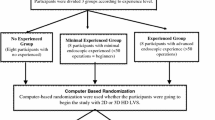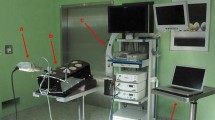Abstract
Background
Three-dimensional (3D) surgical imaging systems provide stereoscopic depth cues that are lost in conventional two-dimensional (2D) display systems. Recent improvements in stereoscopic projection technology using passive polarising displays may improve performance of minimally invasive surgical skills. This study aims to identify the effect of passive polarising stereoscopic displays on novice surgeon performance of minimally invasive surgical skills.
Methods
20 novice surgeons performed 10 repetitions of 4 surgical skills tasks using a new passive polarising stereoscopic display under 3D and 2D conditions. The previously validated tasks used were rope pass, paper cut, needle capping and knot tying. Outcome measures included total error rate and time for task completion.
Results
Novice surgeons demonstrated a significant reduction in error rates for sequential repetitions of each task using the passive polarising stereoscopic display compared with the 2D display. Mean errors for the 3D versus the 2D mode were 2.0 versus 4.3 for rope pass (P ≤ 0.001), 0.8 versus 1.6 for paper cut (P = 0.001), 1.3 versus 4.2 for needle capping (P ≤ 0.001) and 2.8 versus 8.0 for knot tying (P ≤ 0.001). Novice surgeons demonstrated a significant improvement in mean time for completion for all four tasks when using the 3D system. Mean time (in seconds) for 3D versus 2D were 106.5 versus 134.4 for rope pass (P ≤ 0.001), 116.1 versus 176.3 for paper cut (P ≤ 0.001), 76.3 versus 141.6 for needle capping (P ≤ 0.001) and 153.4 versus 252.6 for knot tying (P ≤ 0.001).
Conclusion
Passive polarising stereoscopic displays significantly improve novice surgeon performance during acquisition of minimally invasive surgical skills.









Similar content being viewed by others
References
Wheatstone C (1838) Contributions to the physiology of vision—part the first. On some remarkable, and hitherto unobserved, phenomena of binocular vision. Philos Trans R Soc Lond 128:371–394
Saxena A, Chung SH, Ng A (2006) Learning depth from single monocular images. Adv Neural Inform Process Syst 18:1161
Patel HR, Ribal MJ, Arya M, Nauth-Misir R, Joseph JV (2007) Is it worth revisiting laparoscopic three-dimensional visualization? A validated assessment. Urology 70(1):47–49
Bhayani SB, Andriole GL (2005) Three-dimensional (3D) vision: does it improve laparoscopic skills? An assessment of a 3D head-mounted visualization system. Rev Urol 7(4):211–214
Taffinder N, Smith SG, Huber J, Russell RC, Darzi A (1999) The effect of a second-generation 3D endoscope on the laparoscopic precision of novices and experienced surgeons. Surg Endosc 13(11):1087–1092
Hubber JW, Taffinder N, Russell RC, Darzi A (2003) The effects of different viewing conditions on performance in simulated minimal access surgery. Ergonomics 46(10):999–1016
Kong SH, Oh BM, Yoon H, Ahn HS, Lee HJ, Chung SG, Yang HK (2010) Comparison of two- and three-dimensional camera systems in laparoscopic performance: a novel 3D system with one camera. Surg Endosc 24(5):1132–1143
Jourdan IC, Dutson E, Garcia A, Vleugels T, Leroy J, Mutter D, Marescaux J (2004) Stereoscopic vision provides a significant advantage for precision robotic laparoscopy. Br J Surg 91(7):879–885
Blavier A, Nyssen AS (2009) Influence of 2D and 3D view on performance and time estimation in minimal invasive surgery. Ergonomics 52(11):1342–1349
Falk V, Mintz D, Grünenfelder J, Fann JI, Burdon TA (2001) Influence of three-dimensional vision on surgical telemanipulator performance. Surg Endosc 15(11):1282–1288
Munz Y, Moorthy K, Dosis A, Hernandez JD, Bann S, Bello F, Rockall T (2004) The benefits of stereoscopic vision in robotic-assisted performance on bench models. Surg Endosc 18(4):611–616
Acknowledgements
The authors are grateful for the use of MicrolineTM instruments kindly provided by Elemental Healthcare.
Disclosures
Authors Ralph Smith, Andy Day, Timothy Rockall, Karen Ballard, Michael Bailey and Iain Jourdan have no conflicts of interest or financial ties to disclose.
Author information
Authors and Affiliations
Corresponding author
Rights and permissions
About this article
Cite this article
Smith, R., Day, A., Rockall, T. et al. Advanced stereoscopic projection technology significantly improves novice performance of minimally invasive surgical skills. Surg Endosc 26, 1522–1527 (2012). https://doi.org/10.1007/s00464-011-2080-8
Received:
Accepted:
Published:
Issue Date:
DOI: https://doi.org/10.1007/s00464-011-2080-8




